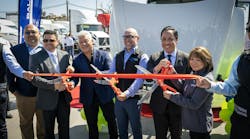Don't underestimate all the potential advantages of an automatic vehicle location (AVL) system.” That advice comes from East Bay Municipal Utility District's (EBMUD) fleet manager, Jonathan Spiegel, who's been using AVL in the water utility's fleet since 1998.
“A lot of people simply see AVL as a tool for dispatch, which is certainly important,” he relates, “but in a complex, multifunction utility operation, there's almost an infinite number of things the system can do.”
EBMUD is now exploring some of the possible uses of Networkcar's Networkfleet wireless vehicle management system. Earlier this year, the District signed a three-year contract with Networkcar, and according to Spiegel, the GPS-based product has already been installed in all of the fleet's dump trucks and backhoes, “allowing for more efficient utilization of those pieces of equipment.”
Networkfleet collects and organizes detailed information about a vehicle's location and performance data directly from the vehicle's electronic engine computer and a global positioning system. The information is then transmitted wirelessly from the truck via a cellular network to Networkcar's operation center, where it is made available online for EBMUD to monitor vehicle location, as well as other important operating data including fuel consumption, mileage, emissions status, speed, etc.
“Because the system is web-based, we can access the information from any computer connected to the Internet. Finding equipment in the field in real-time is very important when you have crews moving around from location to location all day like we do,” Spiegel reports.
Formed in 1923, EBMUD is the West's largest independent water and waste water treatment utility. According to Spiegel, it supplies water and provides wastewater treatment services for 1.2-million people in Alameda and Contra Costa counties in the San Francisco Bay area.
The utility's fleet currently has 1,232 units, ranging from passenger cars to heavy transport vehicles. The breakdown of commercial vehicles is 329 half- and 3/4-ton pickup trucks and vans, 288 one-ton utility trucks, 81 Class 8 trucks and 50 backhoes. The heavy trucks are primarily Freightliner units, including FL 60, 70 and 80s, a few M2s, and Columbia units as well.
The large trucks are mostly dump trucks [10- to 20-yard units], Spiegel says. “We maintain thousands of miles of pipe and several hundred above-ground facilities so these big trucks are primarily used for construction activities, either as dumps or as heavy transport trucks.”
According to Spiegel, a big advantage of Networkfleet is its diagnostic data integration capabilities. “We've integrated it with our own maintenance management software [Fleet Anywhere, by Maximus Software, a strategic partner of Networkcar]. The fleet is far too large to remember what and when equipment needs servicing. We also can't really know the condition of every piece of equipment in the field. But with Networkcar, engine trouble code information is available to us in real time so we can anticipate problems before they occur.”
Another feature of the Networkfleet product that attracted EBMUD is its geofencing capability. “We can create and landmark physical dimensions for the fleet,” Spiegel points out. “Once created, the system can track entry and exits from these geofenced areas, allowing us to track facility traffic and usage without actually being there.”
“Our fleet may be a $50-million asset, but the utility is a billion-dollar business,” says Spiegel “So from a corporate perspective, if fleet information can be integrated to help manage the activities of our 800 field employees, then that's the real potential of a functioning AVL and fleet management system.”


